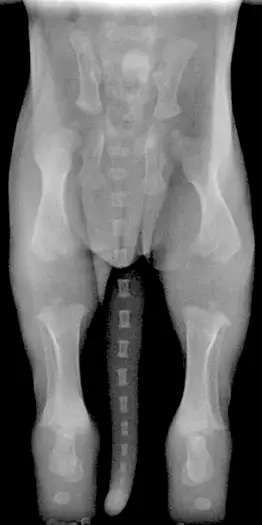
This is a placeholder text
Group text
by joanro on 25 December 2015 - 14:12
The cause of HD is not bad genes causing malformed joint. The various tests for HD are supposedly to help eliminate the "bad" genetics and create HD free dogs throughout the world....fourty years later, hd is still a major health problem.
This from Wayne Riser ( founder of offa) tells a different story from what has evolved into popular myth about the 'cause' of CHD.
" Wayne Riser, who studied hip dysplasia in dogs for many years and was also the founder and first director of the Orthopedic Foundation for Animals, explained it this way (1975):
"In all mammalian embryos, the hip is laid down as a single unit from mesenchymal tissue, and it develops normally as long as the components are left in full congruity. The hip is normal at some time in the development of the mammal, and abnormal development occurs only when stresses pull the components apart.
In the dog, the hip is normal at birth. Intrauterine stresses are not sufficient to produce incongruity of the hip. The first time such forces are great enough is when the pup begins to take its position to nurse.
Observations of the disease in man, dog, and a number of other mammals for many years have culminated in the conviction that the bony changes of hip dysplasia, regardless of species, occur because the soft tiscsues do not have sufficient strength to maintain congruity between the articular surfaces of the femoral head and the acetabulum."
Riser is saying here that muscles, ligaments, and tendons ("soft tissues") normally keep the head of the femur properly seated in the developing socket. But if there are abnormal forces on the joint, the soft tissues might be inadequate to stabilize the joint, and malformation of the socket - hip dysplasia - will occur."
http://www.instituteofcaninebiology.org/blog/how-do-hips-become-dysplastic
It seems obvious that instead looking for "hip improvers" in a ped, one should look at the structure of their dogs and select for muscle deffinition, tight skin rather than wet (loose skin), ligher bone rather than 'big bone', tight small feet rather than 'huge feet', smaller heads rather than huge 'bucket/block heads'...and stop whelping litters in slippery swimming pools and don't overfeed litters from weaning age on, get the litter out in the natural environment as soon as they step out of the nest to explore. HD starts in the whelping box, not in the parents' hip scores.
by Western Rider on 25 December 2015 - 18:12
Jo I so agree with the last paragraph.
It has been many years and I hope more since I have had any pup x-ray with hip problems and add raw food it is a winning way to go.
by Ibrahim on 25 December 2015 - 23:12
by Markobytes on 26 December 2015 - 01:12
by joanro on 26 December 2015 - 01:12
Marko, 'This is a perspective that has been overlooked for too long.'
You are so correct...I know it is the only way to produce healthy dogs...stacking the 'crap shoot'.
by Jyl on 26 December 2015 - 10:12
by joanro on 26 December 2015 - 14:12
 I know the link is not live, so here is an exray from the article of a newborn puppy, that will give perspective to the text of the op. Every where that bone does not show in the skeleton, is cartilage that will become bone.
I know the link is not live, so here is an exray from the article of a newborn puppy, that will give perspective to the text of the op. Every where that bone does not show in the skeleton, is cartilage that will become bone.
by Gigante on 26 December 2015 - 15:12
This meshes well in my mind with the idea that vitamin c deficiencies may ultimately play the greatest role. The soft tissues are generated regenerated with the use of vitamin c so dogs that don't produce enough could be the genetic key passed down that produces hd in their line.
Unknowably the genetic selection of choosing parents with and lines with A1 hips may have just been choosing lines with adequate or very good vitamin c producing dogs.
by yogidog on 26 December 2015 - 15:12
by AnaSilva on 26 December 2015 - 15:12
Thank you Joanro, very interesting post. ![]()
Contact information Disclaimer Privacy Statement Copyright Information Terms of Service Cookie policy ↑ Back to top





